2012 VOLKSWAGEN TRANSPORTER cooling
[x] Cancel search: coolingPage 330 of 486
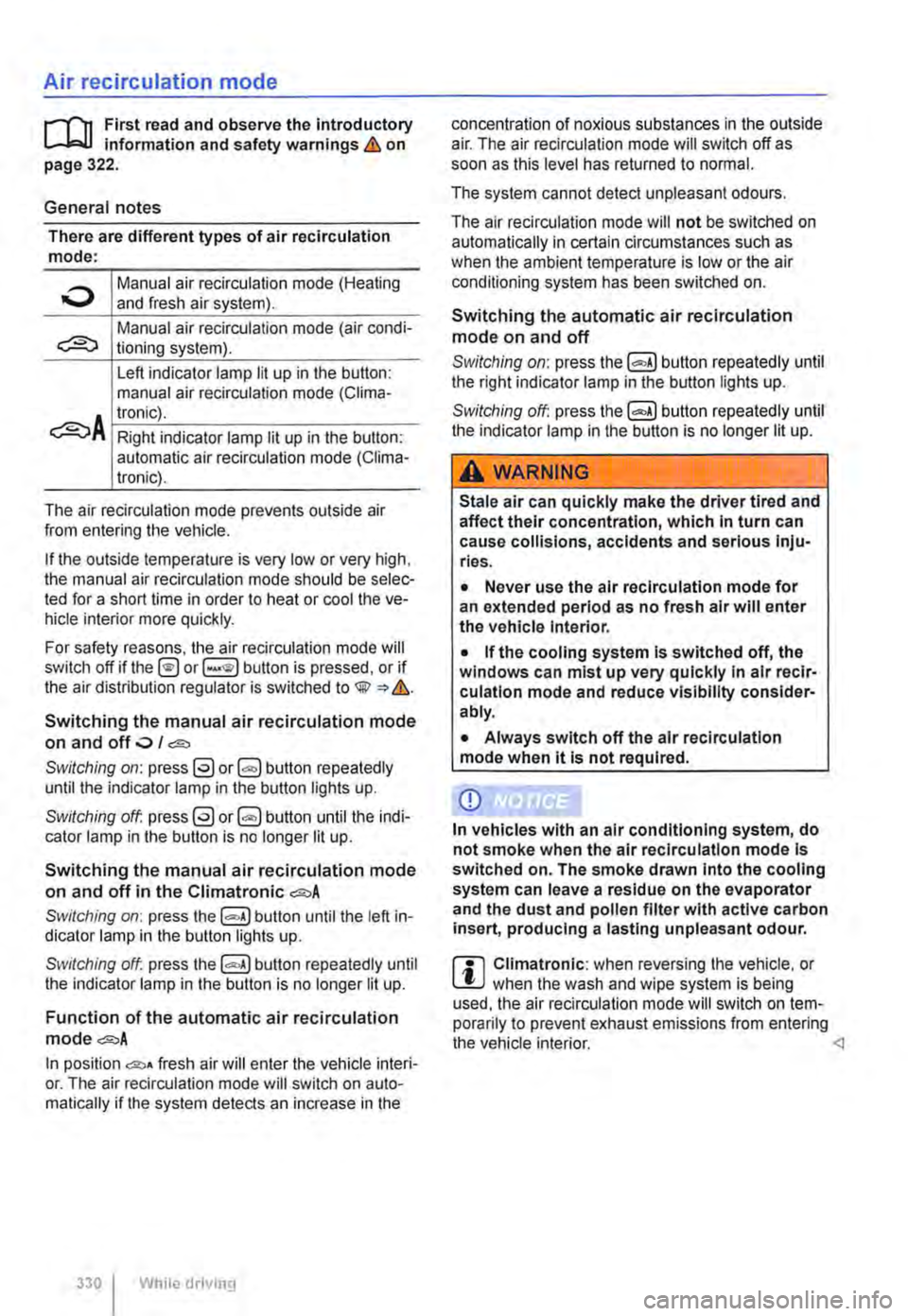
Air recirculation mode
.-r'n First read and observe the introductory information and safety warnings .1:!. on page 322.
General notes
There are different types of air recirculation mode:
Manual air recirculation mode (Heating and fresh air system).
Manual air recirculation mode (air condi-tioning system).
Left indicator lamp lit up in the button: manual air recirculation mode (Ciima-
------------Right indicator lamp lit up in the button: automatic air recircutation mode (Ciima-tronic).
The air recirculation mode prevents outside air from entering the vehicle.
if the outside temperature is very low or very high, the manual air recirculation mode should be selec-ted for a short time in order to heat or cool the ve-hicle interior more quickly.
For safety reasons, the air recirculation mode will switch off if the@ button is pressed, or if the air distribution regulator is switched to lliil => .1:!,.
Switching the manual air recirculation mode on and off .o I c:;;:,
Switching on: press button repeatedly until the indicator lamp in the button lights up.
Switching off. press@) button until the indi-cator lamp in the button is no longer lit up.
Switching the manual air recirculation mode on and off in the Climatronic e<>A
Switching on: press the button until the left in-dicator lamp in the button tights up.
Switching off. press the repeatedly until the indicator lamp in the button is no longer lit up.
Function of the automatic air recirculation mode e<>A
In position a>• fresh air will enter the vehicle interi-or. The air recirculation mode will switch on auto-matically if the system detects an increase in the
330 I While driving
concentration of noxious substances in the outside air. The air recirculation mode will switch off as soon as this level has returned to normal.
The system cannot detect unpleasant odours.
The air recirculation mode will not be switched on automatically in certain circumstances such as when the ambient temperature is low or the air conditioning system has been switched on.
Switching the automatic air recirculation mode on and off
Switching on: press button repeatedly until the right indicator lamp in the button lights up.
Switching off: press button repeatedly until the indicator lamp in the button is no longer lit up.
A WARNING
Stale air can quickly make the driver tired and affect their concentration, which In turn can cause collisions, accidents and serious inju-ries.
• Never use the air reclrculation mode for an extended period as no fresh air will enter the vehicle Interior.
• If the cooling system is switched off, the windows can mist up very quickly In air recir-culatlon mode and reduce visibility consider-ably.
• Always switch off the air reclrculation mode when it is not required.
CD
In vehicles with an air conditioning system, do not smoke when the air reclrculatlon mode Is switched on. The smoke drawn Into the cooling system can leave a residue on the evaporator and the dust and pollen filter with active carbon insert, producing a lasting unpleasant odour.
m Cllmatronic: when reversing the vehicle, or l!J when the wash and wipe system is being used, the air recirculation mode will switch on tem-porarily to prevent exhaust emissions from entering the vehicle interior.
Page 351 of 486
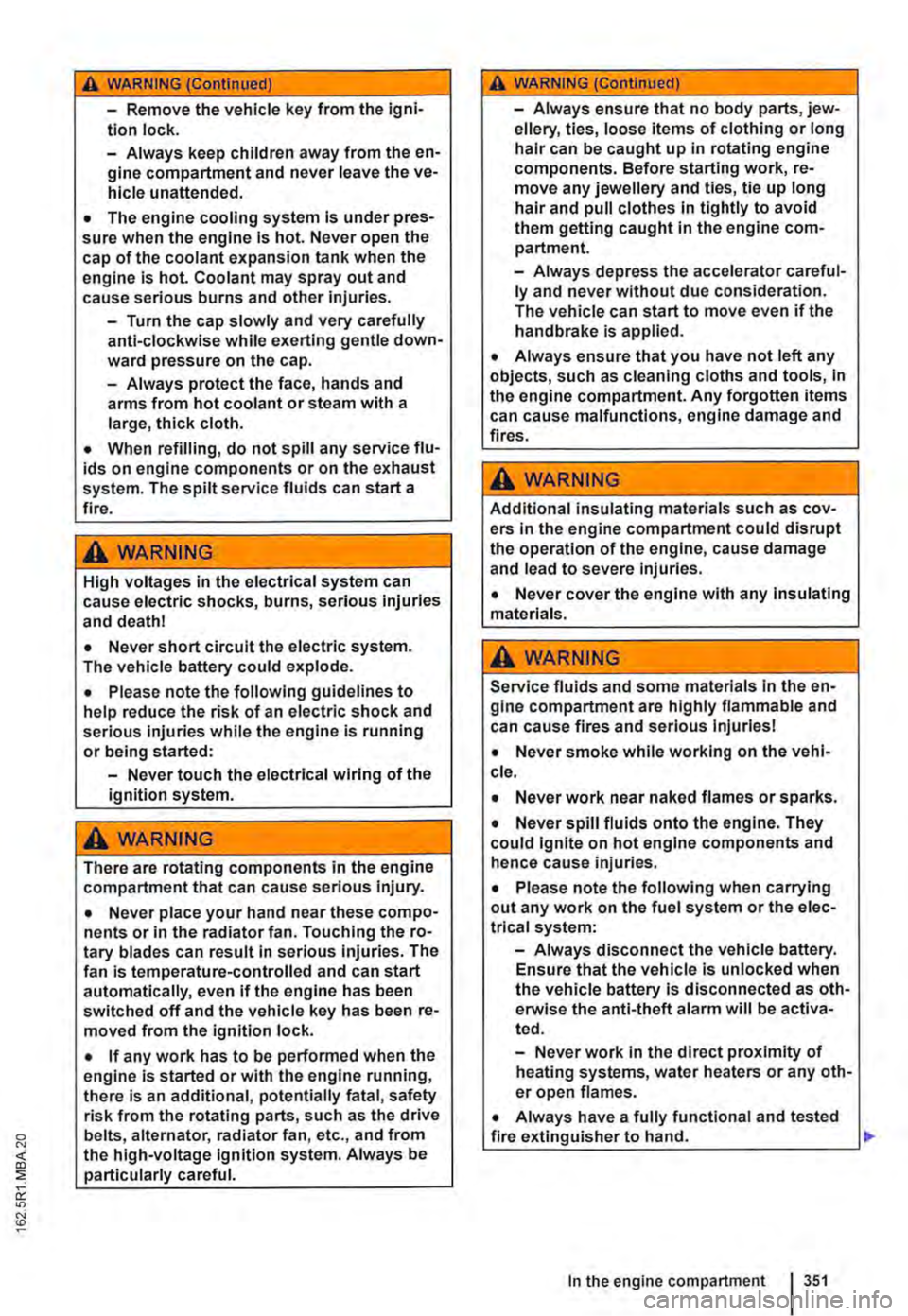
A WARNING (Continued)
-Remove the vehicle key from the igni-tion lock.
-Always keep children away from the en-gine compartment and never leave the ve-hicle unattended.
• The engine cooling system Is under pres-sure when the engine Is hot. Never open the cap of the coolant expansion tank when the engine Is hot. Coolant may spray out and cause serious burns and other Injuries.
-Turn the cap slowly and very carefully anti-clockwise while exerting gentle down-ward pressure on the cap.
-Always protect the face, hands and arms from hot coolant or steam with a large, thick cloth.
• When refilling, do not spill any service flu-ids on engine components or on the exhaust system. The spilt service fluids can start a fire.
A WARNING
High voltages in the electrical system can cause electric shocks, burns, serious injuries and death!
• Never short circuit the electric system. The vehicle battery could explode.
• Please note the following guidelines to help reduce the risk of an electric shock and serious Injuries while the engine is running or being started:
-Never touch the electrical wiring of the Ignition system.
A WARNING
There are rotating components in the engine compartment that can cause serious injury.
• Never place your hand near these compo-nents or In the radiator fan. Touching the ro-tary blades can result in serious injuries. The fan Is temperature-controlled and can start automatically, even if the engine has been switched off and the vehicle key has been re-moved from the ignition lock.
• If any work has to be performed when the engine Is started or with the engine running, there is an additional, potentially fatal, safety risk from the rotating parts, such as the drive belts, alternator, radiator fan, etc., and from the high-voltage ignition system. Always be particularly careful.
A WARNING (Continued)
-Always ensure that no body parts, jew-ellery, ties, loose items of clothing or long hair can be caught up in rotating engine components. Before starting work, re-move any jewellery and ties, tie up long hair and pull clothes In tightly to avoid them getting caught In the engine com-partment.
-Always depress the accelerator careful-ly and never without due consideration. The vehicle can start to move even if the handbrake is applied.
• Always ensure that you have not left any objects, such as cleaning cloths and tools, in the engine compartment. Any forgotten items can cause malfunctions, engine damage and fires.
A WARNING
Additional insulating materials such as cov-ers in the engine compartment could disrupt the operation of the engine, cause damage and lead to severe Injuries.
• Never cover the engine with any Insulating materials.
A WARNING
Service fluids and some materials In the en-glne compartment are highly flammable and can cause fires and serious Injuries!
• Never smoke while working on the vehl-cl e.
• Never work near naked flames or sparks .
• Never spill fluids onto the engine. They could Ignite on hot engine components and hence cause injuries.
• Please note the following when carrying out any work on the fuel system or the elec-trlcal system:
-Always disconnect the vehicle battery. Ensure that the vehicle Is unlocked when the vehicle battery Is disconnected as oth-erwlse the anti-theft alarm will be activa-ted.
-Never work in the direct proximity of heating systems, water heaters or any oth-er open flames.
• Always have a fully functional and tested fire extinguisher to hand.
In the engine compartment I 351
...
Page 360 of 486
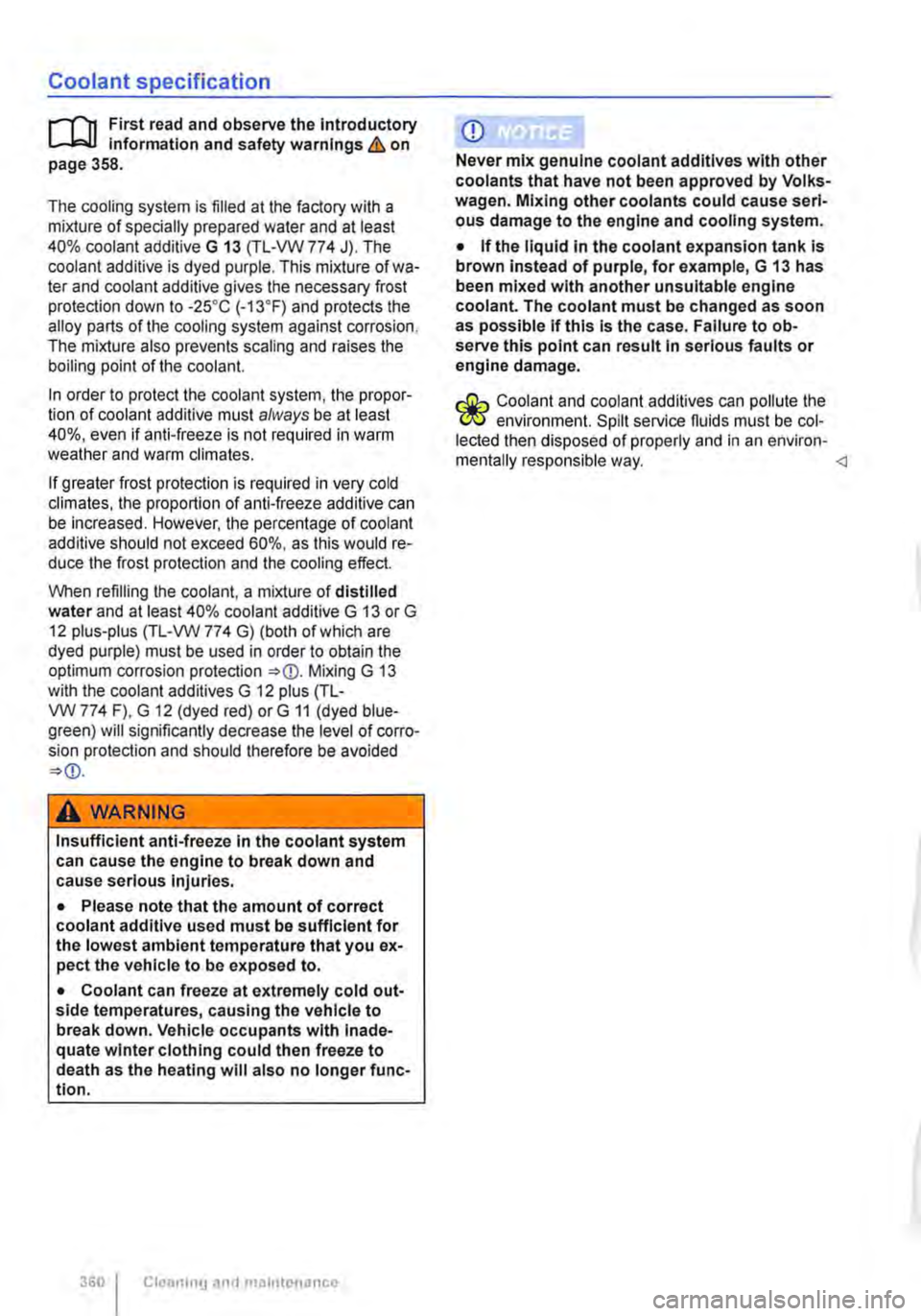
Coolant specification
r-l"'n First read and observe the Introductory l..-J,::,U Information and safety warnings & on page 358.
The cooling system is filled at the factory with a mixture of specially prepared water and at least 40% coolant additive G 13 (fl-VW 774 J). The coolant additive is dyed purple. This mixture of wa-ter and coolant additive gives the necessary frost protection down to -2s•c (-13.F) and protects the alloy parts of the cooling system against corrosion. The mixture also prevents scaling and raises the boiling point of the coolant.
In order to protect the coolant system, the propor-tion of coolant additive must always be at least 40%, even if anti-freeze is not required in warm weather and warm climates.
If greater frost protection is required in very cold climates, the proportion of anti-freeze additive can be increased. However, the percentage of coolant additive should not exceed 60%, as this would re-duce the frost protection and the cooling effect.
When refilling the coolant, a mixture of distilled water and at least 40% coolant additive G 13 or G 12 plus-plus (TL-VW 774 G) (both of which are dyed purple) must be used in order to obtain the optimum corrosion protection =>(]). Mixing G 13 with the coolant additives G 12 plus (Tl-VW774 F), G 12 (dyed red) orG 11 (dyed blue-green) will significantly decrease the level of corro-sion protection and should therefore be avoided =>
Insufficient anti-freeze In the coolant system can cause the engine to break down and cause serious Injuries.
• Please note that the amount of correct coolant additive used must be sufficient for the lowest ambient temperature that you ex-pect the vehicle to be exposed to.
• Coolant can freeze at extremely cold out-side temperatures, causing the vehicle to break down. Vehicle occupants with Inade-quate winter clothing could then freeze to death as the heating will also no longer func-tion.
360 I Cleaning and maintenance
CD
Never mix genuine coolant additives with other coolants that have not been approved by Volks-wagen. Mixing other coolants could cause seri-ous damage to the engine and cooling system.
• If the liquid in the coolant expansion tank is brown instead of purple, for example, G 13 has been mixed with another unsuitable engine coolant. The coolant must be changed as soon as possible if this Is the case. Failure to ob-serve this point can result In serious faults or engine damage.
Coolant and coolant additives can pollute the "7!1:5 environment. Spilt service fluids must be col-lected then disposed of properly and in an environ-mentally responsible way.
Page 362 of 486
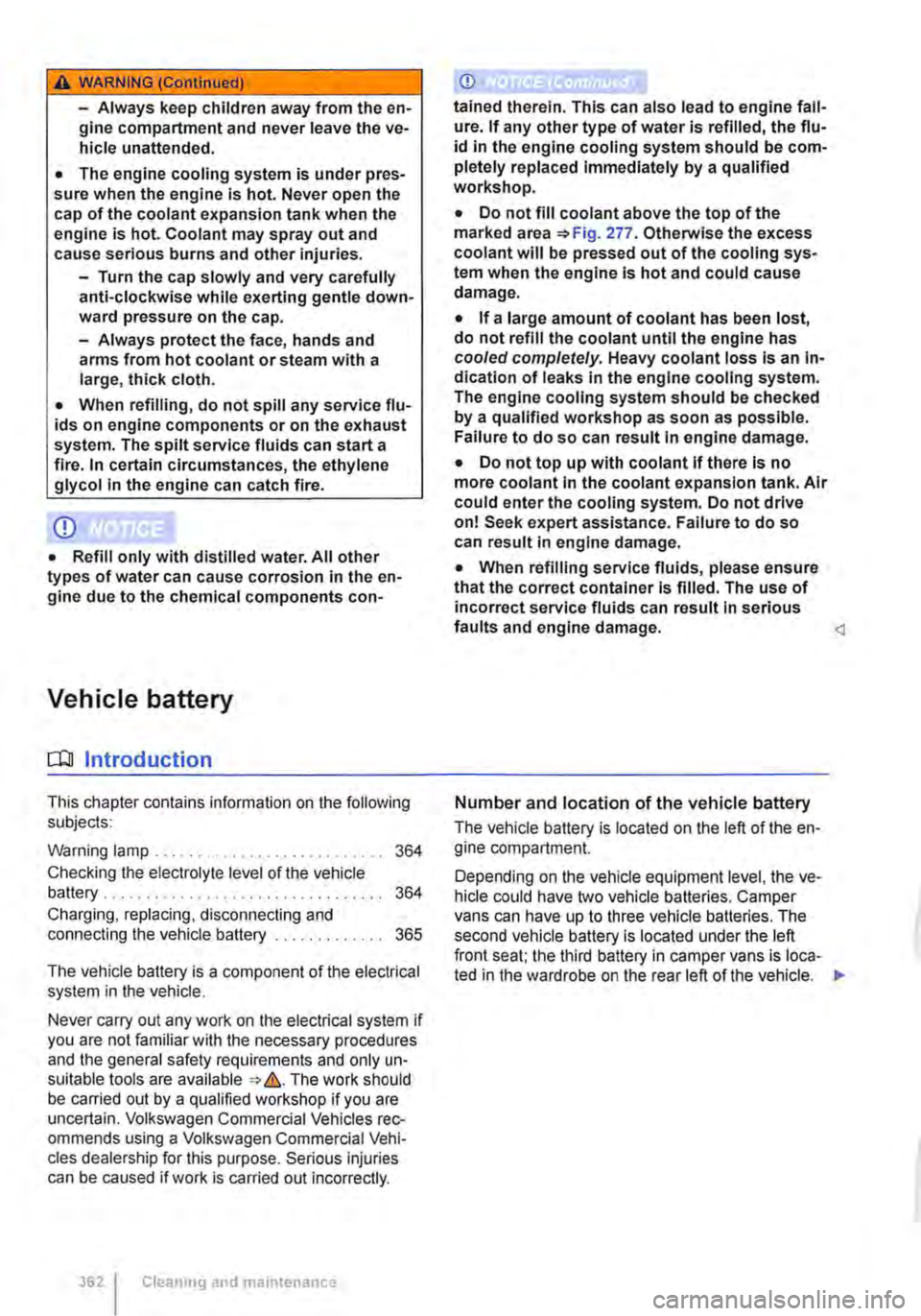
A WARNING (Continued)
-Always keep children away from the en-gine compartment and never leave the ve-hicle unattended.
• The engine cooling system is under pres-sure when the engine is hot. Never open the cap of the coolant expansion tank when the engine is hot. Coolant may spray out and cause serious burns and other injuries.
-Turn the cap slowly and very carefully anti-clockwise while exerting gentle down-ward pressure on the cap.
-Always protect the face, hands and arms from hot coolant or steam with a large, thick cloth.
• When refilling, do not spill any service flu-ids on engine components or on the exhaust system. The spilt service fluids can start a fire. In certain circumstances, the ethylene glycol in the engine can catch fire.
CD
• Refill only with distilled water. All other types of water can cause corrosion in the en-gine due to the chemical components con-
Vehicle battery
CQJ Introduction
This chapter conlains information on the following subjects:
Warning lamp . . . . . . . . . . . . . . . . . . . . . . . . . . . 364
Checking the electrolyte level of the vehicle battery ................................. 364 Charging, replacing, disconnecling and connecting the vehicle battery . . . . . . . . . . . . . 365
The vehicle battery is a component of the electrical system in the vehicle.
Never carry out any work on the electrical system if you are not familiar with the necessary procedures and the general safety requirements and only un-suitable tools are available => &. The work should be carried out by a qualified workshop if you are uncertain. Volkswagen Commercial Vehicles rec-ommends using a Volkswagen Commercial Vehi-cles dealership for this purpose. Serious injuries can be caused if work is carried out incorrectly.
3621 Cleaning and maintenance
(j)
tained therein. This can also lead to engine fail-ure. If any other type of water is refilled, the flu-id in the engine cooling system should be com-pletely replaced immediately by a qualified workshop.
• Do not fill coolant above the top of the marked area =>Fig. 277. Otherwise the excess coolant will be pressed out of the cooling sys-tem when the engine is hot and could cause damage.
• If a large amount of coolant has been lost, do not refill the coolant until the engine has cooled completely. Heavy coolant loss is an in-dication of leaks in the engine cooling system. The engine cooling system should be checked by a qualified workshop as soon as possible. Failure to do so can result in engine damage.
• Do not top up with coolant if there is no more coolant in the coolant expansion tank. Air could enter the cooling system. Do not drive on! Seek expert assistance. Failure to do so can result in engine damage.
• When refilling service fluids, please ensure that the correct container is filled. The use of incorrect service fluids can result In serious faults and engine damage.
The vehicle battery is located on the left of the en-gine compartment.
Depending on the vehicle equipment level, the ve-hicle could have two vehicle batteries. Camper vans can have up to three vehicle batteries. The second vehicle battery is located under the left front seat: the third battery in camper vans is loca-ted in the wardrobe on the rear left of the vehicle. •
Page 396 of 486

should be replaced at a qualified workshop. Volks-wagen Commercial Vehicles dealers are kept up to date with regard to any changes.
A WARNING
Unsuitable service fluids and consumables, and the Incorrect use of these fluids and con-sumables, can cause accidents, serious inju-ries, burns or poisoning.
• Service fluids must be kept In their origi-nal sealed container.
• Never store service fluids In empty food containers, bottles or any other non-original containers as people finding these containers could drink them.
• Keep children away from all service fluids and consumables.
• Always read and follow the Information and warnings on the service fluid packaging.
Repairs and technical modifications
.....-T'n First read and observe the Introductory l-J,::JJ Information and safety warnings & on page 394.
Repairs and modifications must always be car-ried out according to Volkswagen Commercial Vehicles specifications =:ob:,!
Unauthorised modifications to the electronic com-ponents or software in the vehicle may cause faults. As the electronic components are linked to-gether in networks. other systems may be affected by the faults. This can seriously impair safety, lead to excessive wear of components, and also invalid-ate the type approval for the vehicle.
The Volkswagen Commercial Vehicles dealer can-not be held liable for any damage caused by tech-nical modifications and/or work performed incor-rectly.
The Volkswagen Commercial Vehicles dealer can-not be held liable for any damage caused by tech-nical modifications and/or work performed incor-rectly. This is also not covered by the Volkswagen guarantee.
3961 Clt!aning and maintenance
A WARNING (Continued)
• When using products that give off harmful fumes, always work outdoors or In a well-ventilated area.
• Never use fuel, turpentine, engine oil, nail varnish remover or other volatile fluids for vehicle care. They are toxic and highly flam-mable. They could cause fires and explo-sions.
CD
• Only use suitable service fluids for refilling. Never use the wrong service fluid. Failure to observe this warning can result In serious mal-functions and engine damage.
• Optional equipment and other accessories In front of the air Inlet reduce the cooling effect of the coolant. The engine may overheat at high ambient temperatures and high engine loads.
Leaking service fluids can pollute the envi-C!IS ronment. Spilt service fluids must be collec-ted in suitable containers and disposed of properly and with respect for the environment.
Vehicles with special auxiliary equipment or body parts
The manufacturer of these components must en-sure that these parts (fittings) adhere to the stipula-ted environmental laws and regulations, particular-ly the EU directive 2000/53/EC concerning end-of-life vehicles and EU directive 2003/11/EC concern-ing the restriction on the marketing and use of cer-tain dangerous substances and preparations.
The vehicle owner should keep all assembly docu-mentation for these auxiliary fittings, and pass it on to any scrapping company later engaged. This is to facilitate environmentally responsible disposal for all vehicles, Including refitted vehicles.
Windscreen repairs
To function properly, some items of equipment re-quire a camera or sensor, which Is located on the inside of the windscreen near the interior mirror. If the windscreen in the viewing field of the camera ,..
Page 469 of 486
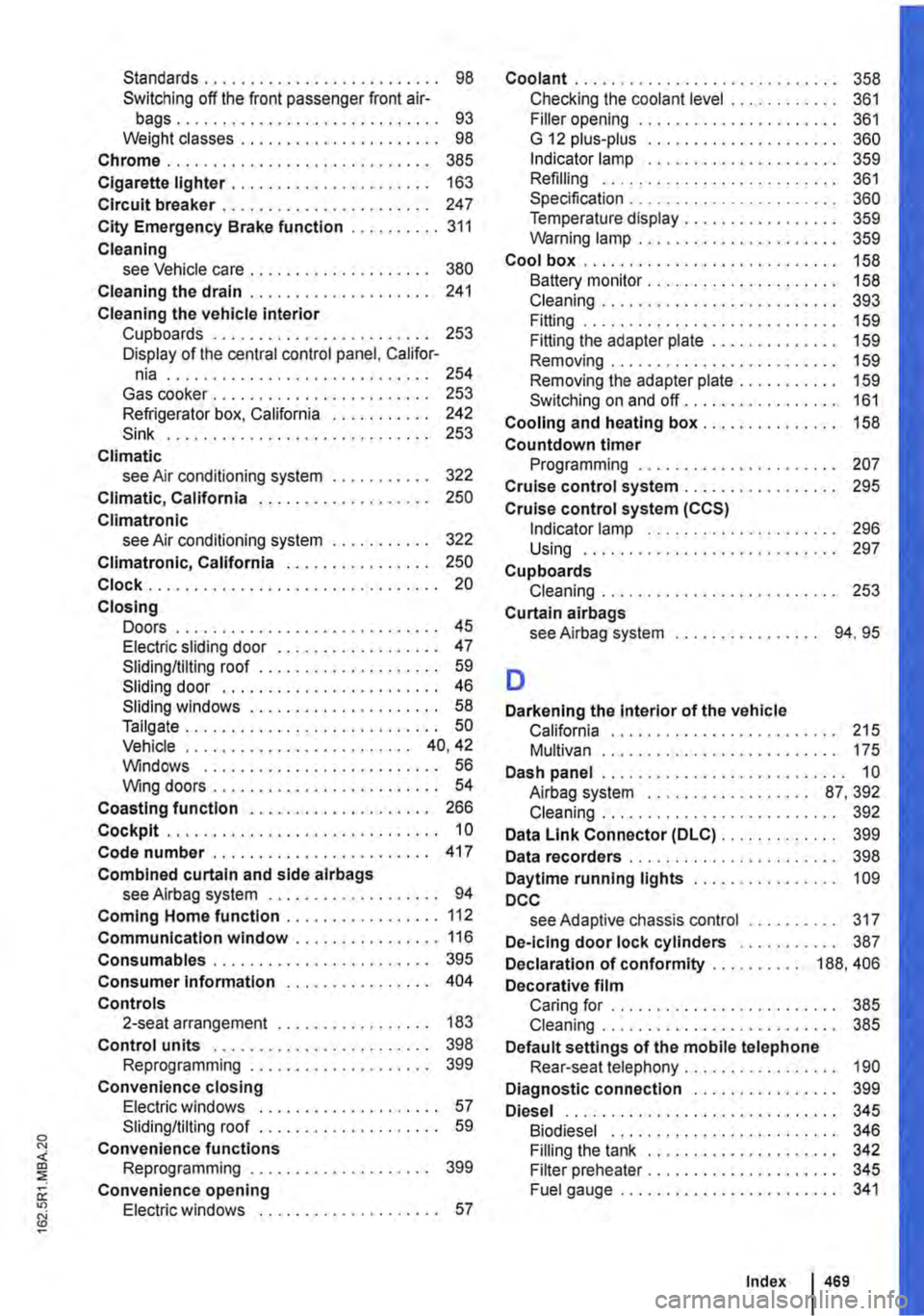
Standards . . . . . . . . . . . . . . . . . . . . . . . . . . 98 Switching off the front passenger front air-bags............................. 93 Weight classes . . . . . . . . . . . . . . . . . . . . . . 98 Chrome ............•................ 385
Cigarette lighter . . . . . . . . . . . . . . . . . . . . . . 163
Circuit breaker . . . . . . . . . . . . . . . . . . . . . . . 247
City Emergency Brake function .......... 311
Cleaning see Vehicle care . . . . . . . . . . . . . . . . . . . . 380
Cleaning the drain . . . . . . . . . . . . . . . . . . . . 241
Cleaning the vehicle interior Cupboards . . . . . . . . . . . . . . . . . . . . . . . . 253 Display of the central control panel, Califor-nia . . . . . . . . . . . . . . . . . . . . . . . . . . . . . 254 Gas cooker . . . . . . . . . . . . . . . . . . . . . . . . 253 Refrigerator box, California . . . . . . . . . . . 242 Sink .....................•....... 253
Climatic see Air condilioning system . . . . . . . . . . . 322
Climatic, California . . . . . . . . . . . . . . . . . . . 250
Climatronic see Air condilioning system . . . . . . . . . . . 322
Cllmatronic, California . . . . . . . . . . . . . . . . 250 Clock ................................ 20
Closing Doors . . . . . . . . . . . . . . . . . . . . . . . . . . . . . 45 Electric sliding door . . . . . . . . . . . . . . . . . . 47 Sliding/tilting roof . . . . . . . . . . . . . . . . . . . . 59 Sliding door . . . . . . . . . . . . . . . . . . . . . . . . 46 Sliding windows . . . . . . . . . . . . . . . . . . . . . 58 Taiigate . . . . . . . . . . . . . . . . . . . . . . . . . . . . 50 Vehicle . . . . . . . . . . . . . • . . . . . . . . . . . 40, 42 Windows ...........•.............. 56 Wing doors . . . . . . . . . . . . . . . . . . . . . . . . . 54
Coasting function . . . . . . . . . . . . . . . . . . . . 266
Cockpit . . . . . . . . . . . . . . . . . . . . . . . . . . . . . . 10 Code number . . . . . . . . . . . . . . . . . . . . . . . . 417
Combined curtain and side alrbags see Airbag system . . . . . . . . . . . . . . . . . . . 94 Coming Home function ................. 112
Communication window ................ 116 Consumables . . . . . . . . . . . . . . . . . . . . . . . . 395
Consumer Information . . . . . . . . . . . . . . . . 404
Controls 2-seat arrangement . . . . . . . . . . . . . . . . . 183
Control units . . . . . . . . . . . . . . . . . . . . . . . . 398 Reprogramming . . . . . . . . . . . . . . . . . . . . 399
Convenience closing Electric windows . . . . . . . . . . . . . . . . . . . . 57 Sliding/tilting roof . . . . . . . . . . . . . . . . . . . . 59
Convenience functions Reprogramming . . . . . . . . . . . . . . . . . . . . 399
Convenience opening Electric windows . . . . . . . . . . . . . . . . . . . . 57
Coolant . . . . . . . . . . . . . . . . . . . . . . . . . . . . . 358 Checking the coolant level . . . . • . . . . . . . 361 Filler opening . . . . . . . . . . . . . . . . . . . . . . 361 G 12 plus-plus . . . . . . . . . . . . . . . . . . . . . 360 Indicator lamp . . . . • . . . . . • . . • . . . . . . . 359 Refilling . . . . . . . . . . . . . . . . . . . . . . . . . . 361 Specification . . . . . . . . . . . . . . . • . . • . . . . 360 Temperature display . . . . . . . . . . . . • . . . . 359 Warning lamp . . . . . . . . . . . . . . . . . . . . . . 359
Cool box . . . . . . . . . . . . . . . . . . . . . . . . . . . . 158 Battery monitor . . . . . . . . . . . . . . . . . . . . . 158 Cleaning . . . . . . . . . . . . . . . . . . . . . . . . . . 393
1W Fitting the adapter plate . . . . . . . . . . . . . . 159 Removing . . . . . . . . . . . . . . . . . . . . . . . . . 159 Removing the adapter plate . . . . . . . . . . . 159 Switching on and off.. . . . . . . . . . . . . . . . 161
Cooling and heating box . . . . . . . . . . . . . . . 158
Countdown timer Programming . . . . . . . . . . . . . . . . . . . . . . 207
Cruise control system . . . . . . . . . . . . . . . . . 295
Cruise control system (CCS) Indicator lamp . . . . . . . . . . . . . . . . . 296 Using . . . . . . . . . . . . . . • . . . . . . . . . 297
Cupboards Cleaning . . . . . . . . . . . . . . . . . . . . . . . . . . 253
Curtain airbags see Airbag system . . . . . . . . . . . . . . . . 94. 95
D
Darkening the interior of the vehicle California . . . . . . . . . . . . . . . . . . . . . . . . . 215 Multivan . . . . . . . . . . . . . . . . . . . . . . . . . . 175
Dash panel . . . . . . . . . . . . . . . . . . . . . . . . . . . 10 Airbag system . . . . . . . . . . . . . . . . . . 87, 392 Cleaning . . . . . . . . . . . . . . . . . . . . . . . . . . 392
Data Link Connector (DLC) . . . . . . . . . . . . . 399 Data recorders . . . . . . . . . . . . . . . . . . . . . . . 398 Daytime running lights . . . . . . . . . . . . . . . . 109
DCC see Adaptive chassis control . . . . . . . . . . 317
De-icing door lock cylinders . . . . . . . 387
Declaration of conformity . . . . . . . . . . 188, 406 Decorative film Caring for . . . . . . . . . . . . . . . . . . . . . . . . . 385 Cleaning . . . . . . . . . . . . . . . . . . . . . . . . . . 385
Default settings of the mobile telephone Rear-seat telephony . . . . . . . . . . . . . . . . . 190
Diagnostic connection . . . . . . . . . . . • . . . . 399 Diesel .............................. 345 Biodiesel . . . . . . . . . . . . . . . . . . . . . . . . . 346 Filling the tank . . . . . . . . . . • . . . . . . . . . . 342 Filter preheater . . . . . . . . . . . . . . . . . . . . . 345 Fuel gauge . . . . . . . . . . . . . . . . . . . . . . . . 341
Index 469